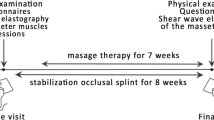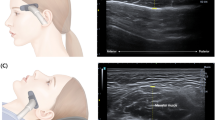Abstract
Objectives
Shear wave elastography (SWE) are promising techniques in diagnosing temporomandibular joint (TMJ) disc and masseter muscle disorders. To investigate normative stiffness values of the TMJ disc and masseter muscle by SWE in children and adolescents.
Methods
This prospective study evaluated 123 TMJ discs and masseter muscles in 123 subjects. The stiffnesses of anterior, middle, and posterior parts of the disc and the masseter muscle were measured. This study investigated differences in mean elasticity [kilopascal (kPa)] and velocity [metre/second (m/s)] values of the different disc parts and the masseter muscle in closed and open mouth positions, and the correlations of these SWE values with age, body mass index (BMI), height, and weight of the subjects.
Results
The median stiffness disc values of all participants were 28.7 kPa (elasticity) and 3.07 m/s (velocity) for the anterior, 29.10 kPa and 3.07 m/s for the middle, and 23.2 kPa and 2.77 m/s for the posterior parts. Posterior stiffness was significantly lower than other body regions in all subjects and across all age groups. The mean stiffness values of the muscle were 16.96 ± 9.01 kPa and 2.33 ± 1.2 m/s for the closed mouth, and 28.7 ± 10.2 kPa and 3.23 ± 1.32 m/s for the open mouth.
Conclusion
The stiffness of the TMJ disc was significantly lower in the posterior part than in the anterior or middle parts. The mean stiffness was significantly higher in the open mouth than in the closed mouth position. Neither elasticity nor velocity were associated with age, height, weight, or BMI.



Similar content being viewed by others
References
Klatkiewicz T, Gawriołek K, Pobudek Radzikowska M, et al. Ultrasonography in the diagnosis of temporomandibular disorders: a meta-analysis. Med Sci Monit. 2018;24:812–7.
Tomas X, Pomes J, Berenguer J, et al. MR imaging of temporomandibular joint dysfunction: a pictorial review. Radiographics. 2006;26:765–81.
Boeddinghaus R, Whyte A. Trends in maxillofacial imaging. Clin Radiol. 2018;73:4–18.
Tamimi D, Kocasarac HD, Mardini S. Imaging of the temporomandibular joint. Semin Roentgenol. 2019;54:282–301.
Kang JH, An YS, Park SH, et al. Influences of age and sex on the validity of bone scintigraphy for the diagnosis of temporomandibular joint osteoarthritis. Int J Oral Maxillofac Surg. 2018;47:1445–52.
Siva Kalyan U, MoturiK Rayalu P. The role of ultrasound in diagnosis of temporomandibular joint disc displacement: a case-control study. J Maxillofac Oral Surg. 2018;17:383–8.
Park JY, Kim JK, Cheon JE, et al. Meniscus stiffness measured with shear wave elastography is correlated with meniscus degeneration. Ultrasound Med Biol. 2020;46:297–304.
Alp NB, Akdağ G, Kaleli T, et al. Evaluation of patellar tendon with shear wave elastography after anterior cruciate ligament reconstruction using hamstring tendons. Jt Dis Relat Surg. 2020;31:137–42.
Hackett L, Aveledo R, Lam PH, et al. Reliability of shear wave elastography ultrasound to assess the supraspinatus tendon: an intra and inter-rater in vivo study. Shoulder Elbow. 2020;12:18–23.
McPherson AL, Nagai T, Schilaty ND, et al. High school male basketball athletes exhibit greater hamstring muscle stiffness than females as assessed with shear wave elastography. Skeletal Radiol. 2020;49:1231–7.
Schrier VJMM, Lin J, Gregory A, et al. Shear wave elastography of the median nerve: a mechanical study. Muscle Nerve. 2020;61:826–33.
Kadasne DK. Kadasne’s textbook of anatomy (clinically oriented): head, neck, face and brain, vol. 3. 1st ed ed. New Delhi: Jaypee Brothers Medical Publishers (P) Ltd; 2009.
Butts R, Dunning J, Perreault T, et al. Pathoanatomical characteristics of temporomandibular dysfunction: Where do we stand? (narrative review part 1). J Bodyw Mov Ther. 2017;21:534–40.
Takashima M, Arai Y, Kawamura A, et al. Quantitative evaluation of masseter muscle stiffness in patients with temporomandibular disorders using shear wave elastography. J Prosthodont Res. 2017;61:432–8.
Manfredini D. Etiopathogenesis of disk displacement of the temporomandibular joint: a review of the mechanisms. Indian J Dent Res. 2009;20:212–21.
Gallo LM, Nickel JC, Iwasaki LR, et al. Stress-field translation in the healthy human temporomandibular joint. J Dent Res. 2000;79:1740–6.
Paluch Ł, Maj P, Pietruski P, et al. Shear wave elastography in the evaluation of temporomandibular joint disorders. Ultrasound Med Biol. 2020;46:46–54.
Dieterich AV, Yavuz UŞ, Petzke F, et al. Neck muscle stiffness measured with shear wave elastography in women with chronic non-specific neck pain. J Orthop Sports Phys Ther. 2020;6:1–27.
Ewertsen C, Carlsen J, Perveez MA, et al. Reference values for shear wave elastography of neck and shoulder muscles in healthy individuals. Ultrasound Int Open. 2018;4:23–9.
Herman J, Sedlackova Z, Vachutka J, et al. Shear wave elastography parameters of normal soft tissues of the neck. Biomed Pap Med Fac Univ Palacky Olomouc Czech Repub. 2017;161:320–5.
Avrillon S, Lacourpaille L, Hug F, et al. Hamstring muscle elasticity differs in specialized high-performance athletes. Scand J Med Sci Sports. 2020;30:83–91.
Ariji Y, Nakayama M, Nishiyama W, et al. Shear-wave sonoelastography for assessing masseter muscle hardness in comparison with strain sonoelastography: study with phantoms and healthy volunteers. Dentomaxillofac Radiol. 2016;45:20150251.
Costa YM, Ariji Y, Ferreira DMAO, et al. Muscle hardness and masticatory myofascial pain: assessment and clinical relevance. J Oral Rehabil. 2018;45:640–6.
Arda K, Ciledag N, Aktas E, et al. Quantitative assessment of normal soft-tissue elasticity using shear-wave ultrasound elastography. Am J Roentgenol. 2011;197:532–6.
Funding
The author(s) received no financial support for the research, authorship and/or publication of this article.
Author information
Authors and Affiliations
Contributions
Study Design was done by MÖ and EÇ; Data Collection was done by EÇ and HAH; Statistical Analysis was carried out by MÖ; Data Interpretation was carried out by EÇ; Manuscript Preparation was done by MÖ and EÇ; Literature Search was done by HAH.
Corresponding author
Ethics declarations
Conflict interests:
The author(s) declared no potential conflicts of interest with respect to the research, authorship and/or publication of this article.
Center of the work:
Department of Pediatric Radiology, İstanbul University, İstanbul School of Medicine, İstanbul, Turkey
Ethical approval:
Since the report did not show any identification with the patient involved, there was no need for ethics committee approval.
Ethical statements:
The study was approved by the Medical Ethics Committee of the Hospital, and all subjects provided written informed consent.
Human rights:
All procedures performed on the reported patients were conducted in accordance with good clinical practice respectful of any human rights.
Informed consent:
Since the report did not show any identification with the patient involved, there was no need for ethics committee approval. Nonetheless, all procedures on the reported patient were subjected to informed consent.
Additional information
Publisher's Note
Springer Nature remains neutral with regard to jurisdictional claims in published maps and institutional affiliations.
Rights and permissions
About this article
Cite this article
Öztürk, M., Çalışkan, E. & Habibi, H.A. Shear wave elastography of temporomandibular joint disc and masseter muscle stiffness in healthy children and adolescents: a preliminary study. Oral Radiol 37, 618–624 (2021). https://doi.org/10.1007/s11282-020-00501-7
Received:
Accepted:
Published:
Issue Date:
DOI: https://doi.org/10.1007/s11282-020-00501-7




